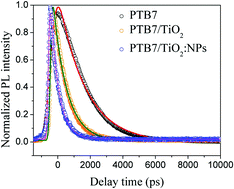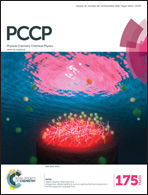Ytterbium–erbium ion doped strontium molybdate (SrMoO4): synthesis, characterization, photophysical properties and application in solar cells
Abstract
In this work, ytterbium–erbium co-doped strontium molybdate (SrMoO4, SMO) nanophosphors (NPs), denoted as SMO:Yb/Er, have been successfully prepared. These NPs were then incorporated into TiO2 acceptor films in hybrid solar cells to enhance light harvesting by virtue of an up-conversion process where low energy photons can be converted into high energy photons through multi-photon processes. The results showed that the SMO:Yb/Er single crystal NPs are capable of turning near infrared photons into visible ones that can be easily captured by poly(thieno[3,4-b]-thiophene/benzodithiophene) (PTB7). The results indicate that the electron transfer rate at the PTB7/TiO2 donor/acceptor interface has been boosted sharply from 0.59 to 1.35 × 109 s−1. Consequently, a hybrid solar cell based on SMO:Yb/Er NP-doped TiO2/PTB7 delivers a high power conversion efficiency of up to 3.61%, thus leading to an efficiency enhancement of around 28% as compared to that of the neat PTB7/TiO2 counterpart (2.81%). This work demonstrates a promising approach to engineering efficient photovoltaic devices by taking advantage of the versatility of rare-earth ion doped oxides that function by modifying light in the solar spectrum.


 Please wait while we load your content...
Please wait while we load your content...